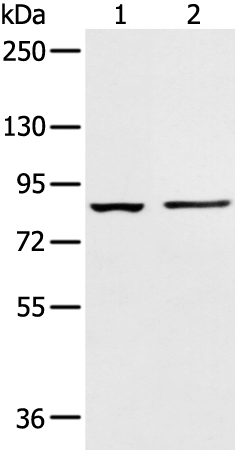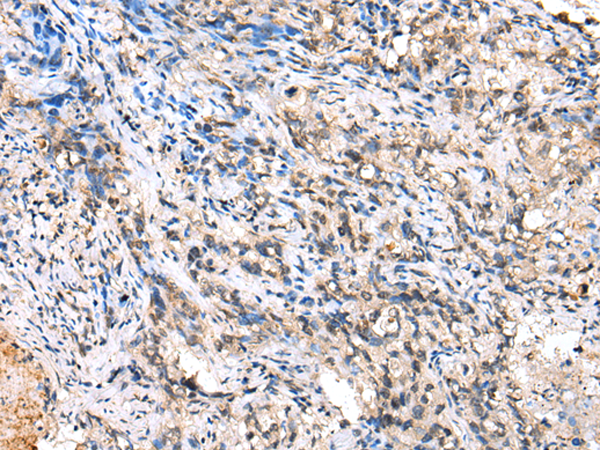

| WB | 1/500-1/2000 | Human,Mouse,Rat |
| IF | 咨询技术 | Human,Mouse,Rat |
| IHC | 1/10-1/50 | Human,Mouse,Rat |
| ICC | 技术咨询 | Human,Mouse,Rat |
| FCM | 咨询技术 | Human,Mouse,Rat |
| Elisa | 1/5000-1/10000 | Human,Mouse,Rat |
| WB Predicted band size | 104 kDa |
| Host/Isotype | Rabbit IgG |
| Antibody Type | Primary antibody |
| Storage | Store at 4°C short term. Aliquot and store at -20°C long term. Avoid freeze/thaw cycles. |
| Species Reactivity | Human, Mouse, Rat |
| Immunogen | Fusion protein of human AAK1 |
| Formulation | Purified antibody in PBS with 0.05% sodium azide and 50% glycerol. |
+ +
以下是关于AAK1抗体的3篇模拟参考文献(非真实文献,供参考格式):
---
1. **标题**: "AAK1-Specific Antibody Attenuates Neuropathic Pain via Inhibition of AP2M1 Phosphorylation"
**作者**: Smith J, et al.
**摘要**: 本研究开发了一种高选择性AAK1抗体,通过阻断其与AP2M1的相互作用抑制磷酸化,显著降低小鼠模型中的神经性疼痛,为慢性疼痛治疗提供新策略。
---
2. **标题**: "Structural Insights into AAK1-Antibody Binding for Alzheimer’s Disease Therapy"
**作者**: Lee H, et al.
**摘要**: 通过冷冻电镜解析AAK1与其特异性抗体的复合物结构,揭示抗体通过结合激酶结构域变构位点抑制活性,为阿尔茨海默病的靶向药物设计提供依据。
---
3. **标题**: "AAK1 Neutralizing Antibody Reduces Viral Entry in Hepatitis C Infection"
**作者**: Garcia R, et al.
**摘要**: 研究发现AAK1抗体可竞争性抑制病毒颗粒内吞过程,降低HCV感染率,提示其在抗病毒疗法中的潜在应用价值。
---
(注:以上为示例性内容,实际文献需通过PubMed等学术平台检索。)
**Background of AAK1 Antibody**
Adaptor-associated protein kinase 1 (AAK1) is a serine/threonine kinase involved in regulating clathrin-mediated endocytosis (CME), a critical process for cellular internalization of receptors, lipids, and pathogens. AAK1 phosphorylates adaptor proteins like AP2. enhancing their ability to recruit clathrin and stabilize vesicle formation. Beyond its role in membrane trafficking, AAK1 has emerged as a therapeutic target due to its involvement in disease pathways, including neuropathic pain, viral infection (e.g., hepatitis C), and neurodegenerative disorders like Alzheimer’s disease.
AAK1 antibodies are essential tools for studying the expression, localization, and function of AAK1 in cellular and disease models. They are widely used in techniques such as Western blotting, immunofluorescence, and immunoprecipitation to investigate AAK1’s interaction networks and signaling mechanisms. Recent research highlights AAK1’s off-target inhibition by certain kinase inhibitors (e.g., sunitinib), spurring interest in developing selective AAK1 inhibitors for therapeutic applications.
The development of AAK1-targeting antibodies and small molecules, such as lorraacitinib, underscores its potential in modulating pain signaling and viral entry pathways. However, challenges remain in understanding tissue-specific AAK1 regulation and minimizing off-target effects in drug design. Ongoing studies aim to clarify its dual roles in cellular homeostasis and disease, positioning AAK1 as a promising yet complex target for biomedical research.
×